By Hudson Sangree
FOLSOM, Calif. — A carbon workshop hosted by the Western Energy Imbalance Market’s Regional Issues Forum on Tuesday underscored how West Coast and Intermountain states can be uneasy partners in CAISO’s real-time energy market.
California has a well-established cap-and-trade program. Oregon is poised to adopt one.
Washington voters rejected a carbon fee bill last year, but the state has pursued aggressive carbon-reduction policies much like California’s, including a 100% clean-energy mandate. (See Western States to Tackle Wildfires, Renewables, EIM Told.)
Some states between the Sierra Nevada and Rocky Mountains, however, have no official carbon policies and continue to burn coal as a significant power source.
Carl Zichella, Western transmission director for the Natural Resources Defense Council, said the EIM has consistently proven its economic benefits since it started in 2014. Its diverse members — eight participants across eight Western states — are “like dogs and cats lying down together,” he said, referring to the fact that investor- and publicly-owned utilities with different business models are working together to capture the benefits of a regional market under the EIM’s framework.
But notable regional differences emerged during a daylong discussion of how to reconcile disparate carbon policies in a centralized energy market such as the EIM. CAISO’s largest meeting room was unusually crowded for the event.
While Californians worried about accounting for carbon leakage in interstate transfers, representatives of Mountain states urged their coastal counterparts to keep politics out of a market that so far has produced more than $650 million in benefits for its voluntary participants.
“I think that adding policy into an economic universe, when you’re bringing in more and more states with diverse policy interests, makes the system more fragile,” said Idaho Public Utilities Commissioner Kristine Raper, a frequent critic of California trying to export its environmental policies to other parts of the West. (See Overheard at Transmission Summit West.)
She said adding politics into the EIM was like stretching a rubber band thinner and thinner until it’s at the snapping point.
“The EIM is clearly an economic benefit to its customers,” but the more policy that is added on, the “more tenuous it gets,” she said.
Utah Public Service Commissioner Jordan White said he thought trying to incorporate carbon policy into the market runs the risk of undermining its ability to optimize energy use among states with and without carbon-reduction goals.
“I hope we don’t erode the efficiency we’ve achieved so far,” he said.
Neither Utah nor Idaho have cap-and-trade or carbon-reduction programs. Some Mountain states are becoming more progressive, however. New Mexico recently joined the growing list of states, including California and Nevada, to adopt goals of relying on 100% clean energy by midcentury. (See Washington, Nevada Join 100% Clean Energy Movement.)
Sarah Cottrell Propst, New Mexico’s secretary of energy, minerals and natural resources, said that under Democratic Gov. Michelle Lujan Grisham, the state is pursuing environmental policies like those farther west. They include providing financial support to utilities that close coal plants and reducing methane emissions from natural gas and oil production.
Public Service Company of New Mexico, the state’s largest utility, has committed to achieving the state’s 100% clean-energy mandate five years ahead of schedule, in 2040, she said. The state’s ample wind and solar production, which exceeds the needs of its relatively small population, will be a major export commodity in the EIM, she said.
“New Mexico is really roaring back in terms of policy and creativity,” Propst said.
California Public Utilities Commissioner Clifford Rechtschaffen took issue with the idea that the energy market would be undermined by policy directives. The CPUC has been dealing with legislative mandates for the past decade without undue problems, he said.
CAISO Vice President Mark Rothleder agreed it would be optimal to have a united carbon policy across the West but said the obstacles may be too difficult to overcome, especially with the EIM expected to add day-ahead trading to its current real-time-only market.
“We need to coordinate on what the overall objectives are,” Rothleder said. “Let’s move forward in a thoughtful way.”





